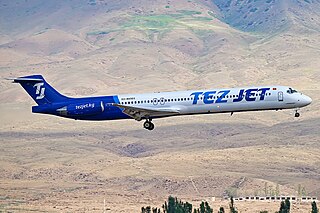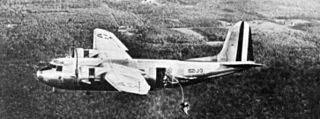Related Research Articles
The Delta Works is a series of construction projects in the southwest of the Netherlands to protect a large area of land around the Rhine–Meuse–Scheldt delta from the sea. Constructed between 1954 and 1997, the works consist of dams, sluices, locks, dykes, levees, and storm surge barriers located in the provinces of South Holland and Zeeland.

A delta wing is a wing shaped in the form of a triangle. It is named for its similarity in shape to the Greek uppercase letter delta (Δ).

The Convair F-106 Delta Dart was an all-weather interceptor aircraft designed and produced by the American aircraft manufacturer Convair.

The McDonnell Douglas MD-80 is a series of five-abreast single-aisle airliners developed by McDonnell Douglas. It was produced by the developer company until August 1997 and then by Boeing Commercial Airplanes. The MD-80 was the second generation of the DC-9 family, originally designated as the DC-9-80 and later stylized as the DC-9 Super 80 . Stretched, enlarged wing and powered by higher bypass Pratt & Whitney JT8D-200 engines, the aircraft program was launched in October 1977. The MD-80 made its first flight on October 18, 1979, and was certified on August 25, 1980. The first airliner was delivered to launch customer Swissair on September 13, 1980, which introduced it into service on October 10, 1980.

The Douglas DC-5 was a 16-to-22-seat, twin-engine propeller aircraft intended for shorter routes than the Douglas DC-3 or Douglas DC-4. By the time it entered commercial service in 1940, many airlines were canceling orders for aircraft. Consequently, only five civilian DC-5s were built. With the Douglas Aircraft Company already converting to World War II military production, the DC-5 was soon overtaken by world events, although a limited number of military variants were produced.

The Pratt & Whitney J75 is an axial-flow turbojet engine first flown in 1955. A two-spool design in the 17,000 lbf (76 kN) thrust class, the J75 was essentially the bigger brother of the Pratt & Whitney J57 (JT3C). It was known in civilian service as the JT4A, and in a variety of stationary roles as the GG4 and FT4.

The Convair XFY-1 Pogo was an experimental V/STOL aircraft developed during the early years of the Cold War. It was intended to be a high-performance fighter aircraft capable of operating from small warships. Lockheed and Convair were awarded contracts to build experimental VTOL fighters, with Convair producing the XFY-1, also known as the "Pogo." It was developed as an attempt to create a practical V/STOL aircraft.

The Osprey GP2 Osprey, also known as the Air Skimmer, Sea Skimmer, or Pereira GP2 Osprey, was a single-seat flying boat designed by Eut Tileston under contract to George Pereira, a private builder. After the release of Pereira's amphibious Osprey II some years later, this aircraft became known retrospectively as the Osprey I. The original plane was designed to be water launched only. Initial test flights were performed in the Sacramento Delta. A single example was evaluated by the United States Navy as the X-28. Pereira formed Osprey Aircraft to market the plans to homebuilders, including plans for a trailer that allows the pilot to launch and recover the aircraft single-handed. These plans are still marketed by Osprey Aircraft as of March 2017.

The Fairey Delta 2 or FD2 is a British supersonic research aircraft that was produced by the Fairey Aviation Company in response to a specification from the Ministry of Supply for a specialised aircraft for conducting investigations into flight and control at transonic and supersonic speeds. Features included a delta wing and a drooped nose. On 6 October 1954, the Delta 2 made its maiden flight, flown by Fairey test pilot Peter Twiss; two aircraft would be produced. The Delta 2 was the final aircraft to be produced by Fairey as an independent manufacturer.

An air speed record is the highest airspeed attained by an aircraft of a particular class. The rules for all official aviation records are defined by Fédération Aéronautique Internationale (FAI), which also ratifies any claims. Speed records are divided into multiple classes with sub-divisions. There are three classes of aircraft: landplanes, seaplanes, and amphibians; then within these classes, there are records for aircraft in a number of weight categories. There are still further subdivisions for piston-engined, turbojet, turboprop, and rocket-engined aircraft. Within each of these groups, records are defined for speed over a straight course and for closed circuits of various sizes carrying various payloads.

The Rutan VariViggen is a homebuilt aircraft designed by Burt Rutan. The aircraft is a tandem two-seater of primarily wooden construction with a delta wing and a canard foreplane. The VariViggen is powered by a 150 hp Lycoming O-320 aero engine in pusher configuration. The prototype was designated Model 27, and the production version was Model 32.

Sharovipteryx is a genus of early gliding reptiles containing the single species Sharovipteryx mirabilis. It is known from a single fossil and is the only glider with a membrane surrounding the pelvis instead of the pectoral girdle. This lizard-like reptile was found in 1965 in the Madygen Formation, Dzailauchou, on the southwest edge of the Fergana Valley in Kyrgyzstan, in what was then the Asian part of the U.S.S.R. dating to the middle-late Triassic period. The Madygen horizon displays flora that put it in the Upper Triassic. An unusual reptile, Longisquama, was also found there.

The Aérospatiale N 262 is a French twin-turboprop high-wing airliner built first by Nord Aviation. The aircraft was also known as the Nord 262.

The Delta was a 12-cylinder inverted-V aircraft engine built by Isotta Fraschini prior to and during World War II.

The Fairey Delta 1 (FD1) was a research aircraft developed and produced by British aircraft manufacturer Fairey Aviation. It holds the distinction of being the first British-designed aircraft to be furnished with a delta wing.

The Zvezda Kh-66 and Kh-23 Grom are a family of early Soviet tactical air-to-surface missiles with a range of 10 km. They were intended for use against small ground or naval targets. The Kh-66 was effectively a heavy-warhead, beam-riding version of the K-8 air-to-air missile rushed into service in Vietnam in 1968. The Kh-23 was an improved Kh-66 with command-guidance, similar to the AGM-12 Bullpup.

The Dyke Delta JD-2 is an American homebuilt aircraft designed in the United States in the 1960s and marketed for amateur construction. It is a monoplane with retractable tricycle undercarriage and seating for four. The wings can be folded for towing or storage and hinge upwards to lie flat above the fuselage, one atop the other. Construction is of SAE 4130 grade steel tube framework with fiberglass and fabric skins.
The Fauvel AV.50 Lutin was a design for an unorthodox light aircraft produced in France in the 1970s. Like some other Charles Fauvel designs, it was a tailless aircraft with a reverse-delta wing. In this case, it was a single-seater intended to be powered by a converted Volkswagen engine. Only one example was known to have been under construction by 1977, in Australia.

The Payen Pa 49 Katy was a small experimental French turbojet powered tailless aircraft, designed by Nicolas Roland Payen, and first flown in 1954. It was the first French aircraft of this kind and the smallest jet aircraft of its day.
Rans Designs, previously called Rans Inc., is an American aircraft and, formerly, a leading American recumbent bicycle and tricycle manufacturer, based in Hays, Kansas, United States. The company name is a portmanteau of the first and last names of the company founder, Randy Schlitter. Rans has produced over 3000 aircraft in kit form and as completed aircraft.
References
- Gunston, Bill (1993). World Encyclopedia of Aircraft Manufacturers. Annapolis: Naval Institute Press. p. 104.
- Jane's All the World's Aircraft 1987-88. London: Jane's Yearbooks. p. 659.